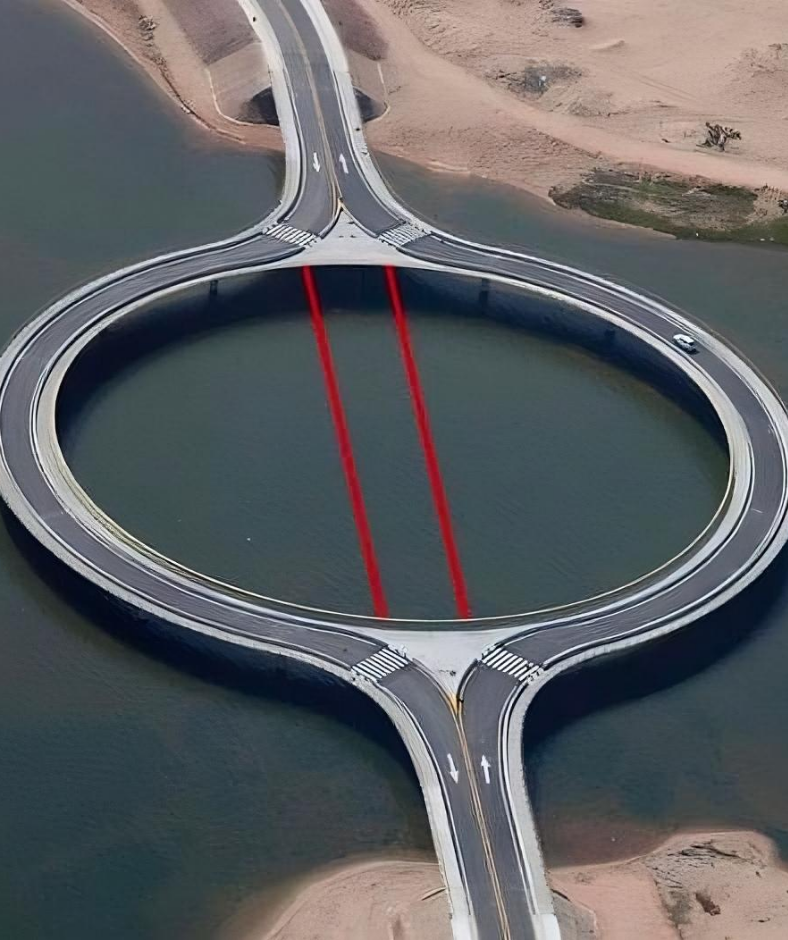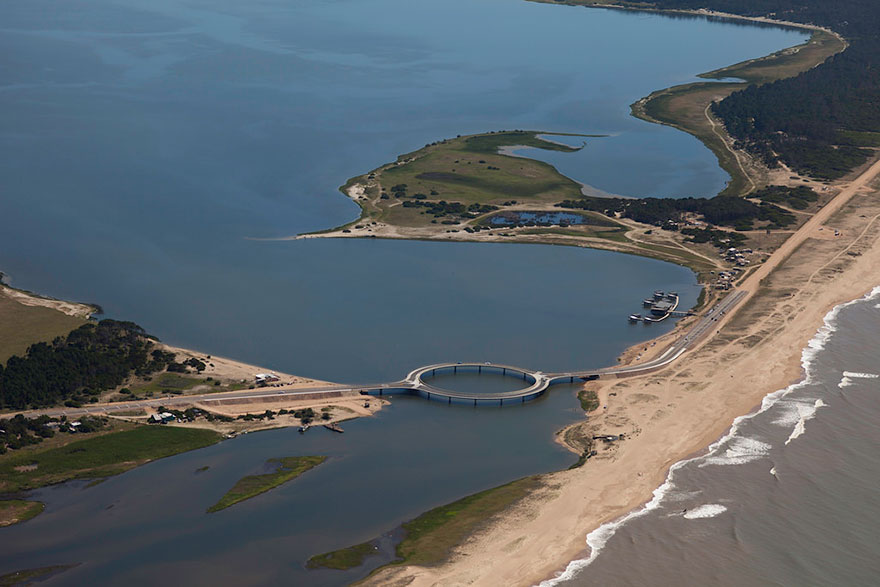In the world of bridge design, practicality often takes precedence, with engineers favoring straight, no-nonsense structures that quickly connect two points. However, Uruguay’s Laguna Garzon Bridge challenges this conventional approach, blending function with artistry. Completed in 2016, this innovative $11 million project not only connects the Rocha and Maldonado departments but also offers a unique experience for all who cross it. By creating a circular bridge, renowned architect Rafael Viñoly has redefined the purpose of infrastructure, transforming a simple crossing into a scenic journey.
The Inspiration Behind the Circular Design

Architect Rafael Viñoly envisioned a bridge that would invite travelers to slow down, appreciate the surroundings, and truly experience the journey. The circular shape wasn’t just an aesthetic choice; it serves a practical purpose. Instead of zooming across a straight bridge, drivers must navigate a gentle curve, which naturally reduces speed and encourages a moment of contemplation.
Viñoly explains, “The concept of the Puente Laguna Garzón was to transform a traditional vehicular crossing into an event that reduces the speed of the cars, to provide an opportunity to enjoy panoramic views to an amazing landscape, and at the same time create a pedestrian place in the center.” In essence, this bridge is designed not just for transportation but for an experience, blending human interaction with nature.
From Rafts to Roads: Solving a Transport Dilemma
Before the Laguna Garzon Bridge, crossing the lagoon required vehicles to be loaded onto rafts, a time-consuming and weather-dependent process. The introduction of the bridge has streamlined this journey, allowing up to 1,000 vehicles to cross daily with ease. The bridge has become a crucial link between Rocha and Maldonado, opening up the once-remote Rocha coastline to tourism and development.
This improved connectivity between regions has had a significant impact on local communities, driving economic growth and increasing access to previously isolated areas. For tourists and locals alike, the bridge now offers a scenic route that highlights the serene beauty of the surrounding landscape, promoting a deeper appreciation for Uruguay’s natural assets.
Engineering the Unique Structure
While circular bridges exist in various parts of the world, they are often designed for pedestrian use or lighter traffic. The Laguna Garzon Bridge, on the other hand, accommodates full-size vehicles, including passenger cars and light trucks. Building a 51.5-meter-radius circular bridge capable of withstanding regular traffic was a bold engineering challenge that Viñoly’s team was more than prepared to tackle.
The bridge features two lanes, each running in a circular path, with a central area designated for pedestrians. This layout not only ensures safe vehicle movement but also provides a gathering space for visitors to take in the breathtaking views. Additionally, the bridge’s curved design creates a central lagoon, ideal for fishing, swimming, and other recreational activities, further integrating the bridge into its natural surroundings.
Economic and Environmental Impact
The Laguna Garzon Bridge has had a profound effect on the region’s economy, helping to boost tourism and drawing attention to the beautiful Rocha coastline. With over 2.9 million visitors to Uruguay in 2015, the bridge has become a key attraction for tourists eager to explore new areas of the country. Beyond tourism, the bridge has facilitated better access to Rocha’s undeveloped coastline, paving the way for sustainable development and bringing new opportunities to the local economy.
From an environmental perspective, the bridge was carefully designed to minimize its impact on the lagoon and surrounding habitats. The project team worked with local environmental groups to ensure that the bridge supported, rather than disrupted, the delicate ecosystem. The bridge’s presence has even contributed to increased awareness about conservation efforts in the area, sparking interest in preserving Uruguay’s natural landscapes.
Architectural Symbolism and Cultural Impact

More than just a means of crossing, the Laguna Garzon Bridge represents a departure from the utilitarian approach to infrastructure. It embodies the idea that architecture can be both functional and beautiful, enhancing our interaction with the natural world. By opting for a circular design, Viñoly has created a space where people can slow down, take in the scenery, and enjoy a moment of tranquility—a rare experience in our fast-paced, modern world.
The bridge has become a cultural symbol, representing Uruguay’s commitment to innovative and environmentally conscious design. It challenges the status quo and serves as a reminder that infrastructure projects can enhance the human experience and coexist harmoniously with nature. In a way, the Laguna Garzon Bridge is a work of art as much as it is a functional structure.
The Future of Bridge Design: Lessons from Laguna Garzon
The success of the Laguna Garzon Bridge has opened the door to new possibilities in bridge design. As architects and engineers strive to create infrastructure that aligns with sustainability goals and enhances public spaces, the circular bridge serves as an inspiring example. It’s a testament to the power of creativity and the willingness to think outside the box, proving that bridges can do more than connect two points—they can connect people with their surroundings.
This bridge is a glimpse into the future of infrastructure, where form and function merge to create something truly extraordinary. As cities and communities worldwide grapple with issues of sustainability, connectivity, and environmental impact, the Laguna Garzon Bridge offers valuable lessons. It reminds us that the structures we build should not only meet practical needs but also inspire, uplift, and promote a sense of connection to the natural world.
Conclusion: A Symbol of Innovation and Unity
The Laguna Garzon Bridge stands as a shining example of what can be achieved when innovative design meets a commitment to sustainability. By challenging traditional ideas of what a bridge should look like and how it should function, Rafael Viñoly has created a structure that is both a marvel of engineering and a celebration of nature. This circular masterpiece reminds us that sometimes, the most remarkable journeys aren’t about reaching the destination but about savoring the path along the way.
Through its unique design, the bridge not only facilitates transportation but also promotes a spirit of contemplation and appreciation for the world around us. As we look to the future, let the Laguna Garzon Bridge serve as a reminder that we have the power to create infrastructure that not only serves practical needs but also enriches our lives, inspires us, and connects us to the natural beauty of our planet.


